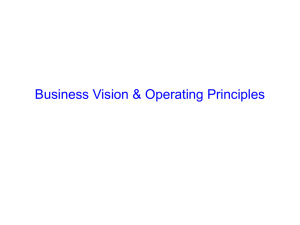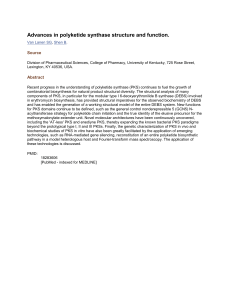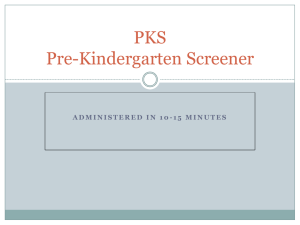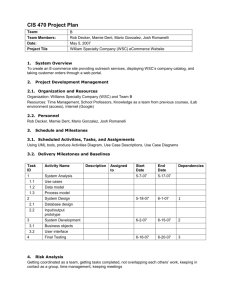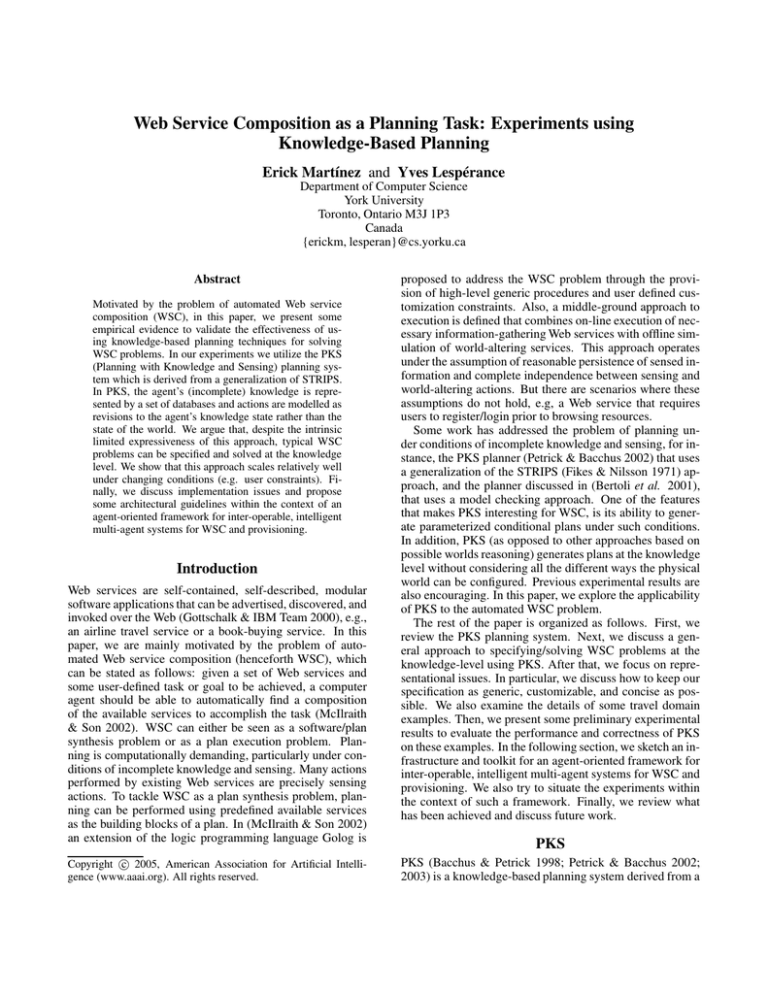
Web Service Composition as a Planning Task: Experiments using
Knowledge-Based Planning
Erick Martínez and Yves Lespérance
Department of Computer Science
York University
Toronto, Ontario M3J 1P3
Canada
{erickm, lesperan}@cs.yorku.ca
Abstract
Motivated by the problem of automated Web service
composition (WSC), in this paper, we present some
empirical evidence to validate the effectiveness of using knowledge-based planning techniques for solving
WSC problems. In our experiments we utilize the PKS
(Planning with Knowledge and Sensing) planning system which is derived from a generalization of STRIPS.
In PKS, the agent’s (incomplete) knowledge is represented by a set of databases and actions are modelled as
revisions to the agent’s knowledge state rather than the
state of the world. We argue that, despite the intrinsic
limited expressiveness of this approach, typical WSC
problems can be specified and solved at the knowledge
level. We show that this approach scales relatively well
under changing conditions (e.g. user constraints). Finally, we discuss implementation issues and propose
some architectural guidelines within the context of an
agent-oriented framework for inter-operable, intelligent
multi-agent systems for WSC and provisioning.
Introduction
Web services are self-contained, self-described, modular
software applications that can be advertised, discovered, and
invoked over the Web (Gottschalk & IBM Team 2000), e.g.,
an airline travel service or a book-buying service. In this
paper, we are mainly motivated by the problem of automated Web service composition (henceforth WSC), which
can be stated as follows: given a set of Web services and
some user-defined task or goal to be achieved, a computer
agent should be able to automatically find a composition
of the available services to accomplish the task (McIlraith
& Son 2002). WSC can either be seen as a software/plan
synthesis problem or as a plan execution problem. Planning is computationally demanding, particularly under conditions of incomplete knowledge and sensing. Many actions
performed by existing Web services are precisely sensing
actions. To tackle WSC as a plan synthesis problem, planning can be performed using predefined available services
as the building blocks of a plan. In (McIlraith & Son 2002)
an extension of the logic programming language Golog is
c 2005, American Association for Artificial IntelliCopyright gence (www.aaai.org). All rights reserved.
proposed to address the WSC problem through the provision of high-level generic procedures and user defined customization constraints. Also, a middle-ground approach to
execution is defined that combines on-line execution of necessary information-gathering Web services with offline simulation of world-altering services. This approach operates
under the assumption of reasonable persistence of sensed information and complete independence between sensing and
world-altering actions. But there are scenarios where these
assumptions do not hold, e.g, a Web service that requires
users to register/login prior to browsing resources.
Some work has addressed the problem of planning under conditions of incomplete knowledge and sensing, for instance, the PKS planner (Petrick & Bacchus 2002) that uses
a generalization of the STRIPS (Fikes & Nilsson 1971) approach, and the planner discussed in (Bertoli et al. 2001),
that uses a model checking approach. One of the features
that makes PKS interesting for WSC, is its ability to generate parameterized conditional plans under such conditions.
In addition, PKS (as opposed to other approaches based on
possible worlds reasoning) generates plans at the knowledge
level without considering all the different ways the physical
world can be configured. Previous experimental results are
also encouraging. In this paper, we explore the applicability
of PKS to the automated WSC problem.
The rest of the paper is organized as follows. First, we
review the PKS planning system. Next, we discuss a general approach to specifying/solving WSC problems at the
knowledge-level using PKS. After that, we focus on representational issues. In particular, we discuss how to keep our
specification as generic, customizable, and concise as possible. We also examine the details of some travel domain
examples. Then, we present some preliminary experimental
results to evaluate the performance and correctness of PKS
on these examples. In the following section, we sketch an infrastructure and toolkit for an agent-oriented framework for
inter-operable, intelligent multi-agent systems for WSC and
provisioning. We also try to situate the experiments within
the context of such a framework. Finally, we review what
has been achieved and discuss future work.
PKS
PKS (Bacchus & Petrick 1998; Petrick & Bacchus 2002;
2003) is a knowledge-based planning system derived from a
generalization of STRIPS. In STRIPS, the state of the world
is represented by a database and actions are represented as
updates to that database. The PKS system uses, instead of a
single database, a set of databases that represent the agent’s
knowledge rather than the state of the world. Actions are
modelled as knowledge-level modifications to the agent’s
knowledge and specified as updates to these databases.
Databases: There are four available databases, each one
storing a different type of knowledge. The contents of these
databases have a fixed formal interpretation in a first-order
modal logic of knowledge that characterizes the agent’s
knowledge state.
Kf : This database can contain any ground literal. In particular, it can store positive and negative facts known to the
agent. Kf can also contain formulas specifying knowledge
of the value of a function on fixed arguments. The closed
world assumption does not apply.
Kw : This database stores formulas whose truth value the
agent knows. In particular, Kw can contain any conjunction
of ground atomic formulas. Intuitively, Kw (α) means that
at planning time we have that either the agent knows α or
it knows ¬α. The agent will only resolve this disjunction
at execution time. This database is used for plan time modelling of the effects of sensing actions.
Kv : This database contains information about function values. In particular, Kv can store unnested function terms
whose values are known to the agent at execution time. Kv
is used for plan time modelling of the effect of sensing actions that return numeric values.
Kx : This database contains information about disjunctive (exclusive or) knowledge of ground literals of the form
(l1 |l2 |...|ln ). Intuitively, this formula represents the fact that
the agent knows that exactly one of the li is true.
Note that the only forms of incomplete knowledge that can
be expressed are complete lack of knowledge about an atom,
by leaving it out of Kf , knowledge of whether an atom holds
(or what a function value is), by putting it in Kw (or in Kv );
and knowledge that only one of a finite set of literals is true
using Kx . There is no reasoning by cases other than by going through a set of cases that have been explicitly enumerated.
Goals: Simple goals can be represented as primitive queries.
A primitive query can take one of the following forms: (i)
K(α), is α known to be true? (ii) K(¬α), is α known to
be false? (iii) Kw (α), does the agent know whether α? (iv)
Kv (t), does the agent know the value of t? (v) the negation of any of the previous queries. In the above, α represents any ground atomic formula, and t represents any variable free term. Complex queries include primitive queries,
conjunctions of queries, disjunctions of queries, and quantified queries where the quantification ranges over the set of
known objects. Complex goals can be expressed as complex
queries.
Actions: Actions are specified in terms of three components: parameters, preconditions, and effects. For example in Table 1, the specifications for actions open(r) and
search(r) are given. The former is a physical action to open
(the door to) a room. The later is a knowledge-producing
action that senses for the presence of a person in a room.
Action
open(r)
search(r)
Precondition
K(room(r))
K(¬opened(r))
K(room(r))
¬Kw (f ound(r))
K(opened(r))
Effects
add(Kf , opened(r))
add(Kw , f ound(r))
Table 1: open and search actions.
Domain Specific Update Rules
K(room(r)) ∧(K(f ound(r)) ⇒
add(Kf , done)
Table 2: DSUR example.
Action open(r) requires the agent to know that room r is
not already open as a precondition. The effect of open(r)
is modelled by the addition of the new fact opened(r) to
the Kf database. Action search(r) requires, as a precondition, the agent to know that room r is already open and
not knowing about whether someone has been found yet in
room r. The effect of search(r) is that the agent comes to
know whether someone was found in room r. This is modelled by adding a new literal f ound(r) to the Kw database.
Note that the preconditions in this case are a conjunction of
primitives queries. Actions’ effects are specified as a set of
database updates, some of which can be conditional.
Domain specific update rules (DSUR): These rules are
used to specify additional action effects and correspond to
state invariants at the knowledge level. In any knowledge
state, DSURs may be triggered provided their conditions are
satisfied. A DSUR example is given in Table 2. This rule
captures the additional action effect of marking the search
task as finished when someone is found in any room. Note
that the antecedent of a DSUR can be any query formula,
and the consequent must be a set of database updates.
Planning problems: A planning problem in PKS is defined
as a tuple hI, A, U, Gi, where I is the initial state, A is a
nonempty set of action specifications, U is a set of DSURs,
and G is a goal condition.
The PKS system relies on an efficient, but incomplete,
inference algorithm that uses a forward chaining approach
to find plans (Bacchus & Petrick 1998). PKS’s efficiency
comes as a result of its limited expressiveness with respect to
the kinds of incomplete knowledge that can be represented.
The current implementation supports both undirected depthfirst search and breadth-first search (used to find shortest
plans).
Composing Web Services in PKS
One of the features that makes the PKS planning system attractive, for the automated WSC task, is its ability to generate parameterized conditional plans (containing run-time
variables) in the presence of incomplete knowledge and
sensing. Also, plans are generated at the knowledge level
without considering all the different ways the physical world
can be configured and changed by actions. In (Petrick &
Bacchus 2002) some experiments are described which show
“impressive performance” on generating plans in a number
of classic planning domains and problems (e.g., bomb in the
toilet, medicate, opening a safe and Unix domains). The
authors also claim that, for many common problems, this
knowledge-based representation “scales better and supports
features that makes it applicable to much richer domains”.
The main motivation for our experiments is to test both
the applicability and scalability of this approach to the WSC
problem. In this paper, we primarily address WSC as a plan
synthesis problem. Therefore, we do not discuss other issues like plan execution and contingency recovery. Given
a particular domain specification and a description of some
user defined goals and explicit preferences, we use the PKS
planning system to generate conditional plans that solve the
task. In our approach each PKS primitive action corresponds to an available service. In particular, knowledgeproducing actions correspond to information-gathering services and physical actions to world-altering services. We
think that, in principle, this approach is modular and flexible. If a new Web service becomes available we can add it
as a new primitive action to the domain specification. Moreover, we can handle cases that previous approaches (McIlraith & Son 2002) cannot, e.g., physical actions having a direct effect on sensing actions. Also, we do not need to have
pre-specified generic plans. However, as can be expected
with offline simulation, our search space is likely to be large
as our conditional plans should cover all the possible alternatives.
Representing Web Services in PKS
One motivation in these experiments is to keep our specifications as general, customizable and intuitive as possible,
so that they can be reused by different users under changing
conditions. Given the current representational restrictions of
PKS, we often cannot represent the user’s objective as a goal
formula alone, e.g. a general non-exclusive disjunctive goal
of the form K(P (~x) ∨ Q(~x)). Nevertheless, one can often
get around this limitation by introducing a new fluent for the
goal and adding DSURs that make it true under appropriate conditions, e.g. when one of the disjuncts holds. We
will show instances of this in the BBF and BPBF problems
below.
We address the generic representation issue by keeping
the action specifications as decoupled as possible from the
specifics of the goal of a planning problem. We also want to
be able to plug in new available services by simply adding
the corresponding primitive actions to the domain specification. By separating all goal specific action effects, we get
a more modular and generic representation to meet the requirements of different users.
To make our specification accommodate user constraints/preferences, we adopt some of the ideas of (McIlraith & Son 2002). For each action ai we introduce a fluent
desAi that encapsulates the necessary conditions that make
ai desirable for execution for a given user. The desirable
fluent is added to the preconditions of each action. For example, a typical knowledge-producing action that senses the
temperature of a room is defined in Table 3. Note that we
Action
sT emp(x)
Precondition
K(room(x))
K(heatOn(x))
K(desST emp(x))
Effects
add(Kv , temp(x))
Table 3: sT emp action.
also need to specify the values of desirable fluents in the initial state and now they change as actions are performed using
DSURs. We should also separate user preference constraints
from those used for search control. To that end we can introduce a fluent indAi that encodes the control information
that makes action ai indicated. These indicated fluents serve
as an optimization mechanism that allows us to add further
restrictions to the search space, in order to avoid unnecessary branching (e.g., it is indicated to sense the temperature
of a room only if the agent already knows there is someone there). However, for simplicity, in this paper we express
search control constraints using the desirable fluents.
We think that this form of action specification in PKS is
well suited for WSC problems as it is easy to understand and
maintain, as well as more extensible and reusable. Nevertheless, the knowledge engineer must be careful in introducing
DSURs, because of the associated computational overhead.
The rest of this section describes a particular domain specification using PKS. Our actual experiments involve WSC
for an air travel domain with five different variations on the
problem of booking a flight between two cities under different customizing user constraints. For simplicity, we assume
that all information regarding origin, destination, departure
and arrival dates is already known and leave these parameters implicit. Otherwise, functional fluents can be introduced
to model the knowledge acquisition. We envision that an executor agent can add all this complementary information at
execution time. Moreover, there is significant advantage to
this, both in terms of getting a more compact representation
of the domain and increased performance at planning time.
All the problems described in this paper, share the basic domain specification elements given in Table 4. In
this domain, four basic Web services are available: (i)
f indRF light(c), i.e., check if a flight exists on company c for the (implicit) desired cities and dates, (ii)
checkF Space(c), i.e., check whether it has seats available, (iii) checkF Cost(c), i.e., find out its price and (iv)
bookF light(c), i.e., book it. As expected, sensing actions
correspond to information-gathering services and physical
actions to world-altering services. We consider a fixed set of
air companies and in the initial state, the agent always knows
what these companies are (perhaps as a result of having used
another existing information-gathering service). Additional
action effects are represented by DSURs. In particular, rules
(1) and (2) capture some effects of sensing for a flight. If the
agent actually finds a flight, then it comes to know what the
flight number is. On the other hand, if the agent finds that
no such a flight exists, then it follows that the flight is not
available. Rules (3) and (4) capture a simple search control
constraint: the agent should only check for the price of a
flight already known to have available space. The specifics
Action
f indRF light(x)
Precondition
Effects
K(airCo(x))
add(Kw , f lightExists(x))
¬Kw (f lightExists(x))
add(Kf , ¬desF indRF light(x))
K(desF indRF light(x))
checkF Space(x) K(airCo(x))
add(Kw , availF light(x))
¬Kw (availF light(x))
add(Kf , ¬desCheckF Space(x))
Kv (f lightN um(x))
K(desCheckF Space(x))
checkF Cost(x)
K(airCo(x))
add(Kv , f lightCost(x))
¬Kv (f lightCost(x))
add(Kf , ¬desCheckF Cost(x))
K(f lightExists(x))
K(desCheckF Cost(x))
bookF light(x)
K(airCo(x))
add(Kf , bookedF light(x))
¬K(bookedF light(x))
del(Kf , availF light(x))
K(availF light(x))
add(Kf , ¬desBookF light(x))
K(desBookF light(x))
Domain specific update rules
K(airCo(x)) ∧ ¬Kv (f lightN um(x)) ∧ K(f lightExists(x)) ⇒
add(Kv , f lightN um(x))
(1)
K(airCo(x)) ∧ ¬K(¬availF light(x)) ∧ K(¬f lightExists(x)) ⇒
add(Kf , ¬availF light(x))
(2)
K(airCo(x)) ∧ ¬Kw (desCheckF Cost(x)) ∧ K(availF light(x)) ⇒
add(Kf , desCheckF Cost(x))
(3)
K(airCo(x)) ∧ ¬Kw (desCheckF Cost(x)) ∧ K(¬availF light(x)) ⇒
add(Kf , ¬desCheckF Cost(x))
(4)
Table 4: Basic air travel domain action specification.
of each version of the problem are captured by the goal, initial state specification, and a set of additional DSURs.
Problem BPF: This problem involves a simple user customization constraint: (s)he has a preferred company. In
the initial state, the agent knows what the user’s preferred
company is. It also knows that actions f indRF light(x) and
checkF Space(x) are always desirable. The goal is either to
book a flight with the preferred company, or with any other
company if the preferred one is not available. For convenience, we introduce a couple of abbreviations, i.e., (5) and
(6):
.
KnowN oF lightExists =
∀k (x)[K(airCo(x)) ⇒
(5)
K(¬f lightExists(x))]
.
KnowN oAvailF light =
∃k (x)[K(airCo(x))∧
K(f lightExists(x))]∧
∀k (x)[(K(airCo(x))
(6)
⇒ Kw (f lightExists(x))]∧
∀k (x)[(K(airCo(x))∧
K(f lightExists(x)))
⇒ K(¬availF light(x))]
(5) is self-explanatory and (6) encodes the case where there
is no seat available. Note that quantifiers are restricted to
range over the set of known objects/constants in the domain.
The goal can then be represented as shown in (7):
% book pref. company
∃k (x)[K(airCo(x)) ∧ K(bookedF light(x))∧
K(pref AirCo = x)] |
% if pref. company not available book any other
∃k (x)[K(airCo(x)) ∧ K(bookedF light(x))∧
K(pref AirCo 6= x)∧
(K(¬f lightExists(pref AirCo)) |
K(¬availF light(pref AirCo)))] |
% no flight booked
KnowN oAvailF light |
KnowN oF lightExists
(7)
Also note the use of ’|’ to denote (ordinary) disjunctions. We
need to add a few update rules to the initial specification to
make this work. Update rule (8) says that if it is known that
a company has no space on its flight, then it is not desirable
to book it. Update rule (9) says that a flight from a company
other than the preferred company can only be desirable to
book if the agent already knows that the preferred company
is not available. Note that the positive case of rule (8) should
also be added, i.e., it is desirable to book the preferred com-
mum price tag should be considered for booking.
pany if available.
K(airCo(x)) ∧ K(¬availF light(x))∧
¬Kw (desBookF light(x))∧
⇒ add(Kf , ¬desBookF light(x))
K(airCo(x)) ∧ K(availF light(x))∧
K(pref AirCo 6= x)∧
¬Kw (desBookF light(x))∧
K(¬desBookF light(pref AirCo))
⇒ add(Kf , desBookF light(x))
(8)
(9)
Problem BMxF: This problem involves a different user customization constraint, the user has a maximum price that
(s)he is willing to pay. As before, the agent initially knows
that actions f indRF light(x) and checkF Space(x) are always desirable. Additionally, the agent knows what the
user’s price limit is. For convenience, we introduce another
abbreviation:
.
KnowN oBudgetF light =
∃k (x)[ K(airCo(x)) ∧ K(f lightExists(x)) ∧
K(availF light(x)) ] ∧
∀k (x)[ (K(airCo(x)) ⇒
Kw (f lightExists(x)) ∧ Kw (availF light(x))) ] ∧
∀k (x)[ (K(airCo(x)) ∧ ¬K(¬f lightExists(x)) ∧
¬K(¬availF light(x)))
⇒ K(priceGtM ax(x)) ]
(10)
(10) represents the case where there is at least one available
flight but none within the budget. The goal is to book any
flight with price equal or less than the maximum price tag.
This is represented as follows:
% book company within budget
∃k (x)[K(airCo(x)) ∧ K(bookedF light(x))∧
K(¬priceGtM ax(x))] |
% no flight booked
KnowN oBudgetF light |
KnowN oAvailF light |
KnowN oF lightExists
(11)
We must also add some DSURs to the initial specification. The update rule (12) captures the notion that if the
cost of a flight is known, then it is also known whether
or not it is greater than the maximum price. Note that
in order to branch on the truth value of the inequality
(f lightCost(x) > userM axP rice) we need to introduce
the fluent priceGtM ax(x) (the current implementation of
PKS is unable to branch on the truth value of expressions
that cannot be reduced to a numeric quantity at plan time;
this issue is supposed to be addressed in a coming release
of the planner). Rules (13) and (14) encode the maximum
price constraint as only flights that do not exceed the maxi-
K(airCo(x)) ∧ ¬Kw (priceGtM ax(x))∧
Kv (userM axP rice) ∧ Kv (f lightCost(x))
⇒ add(Kw , priceGtM ax(x))
(12)
K(airCo(x)) ∧ K(¬priceGtM ax(x))∧
¬Kw (desBookF light(x))
⇒ add(Kf , desBookF light(x))
(13)
K(airCo(x)) ∧ K(priceGtM ax(x))∧
¬Kw (desBookF light(x))∧
⇒ add(Kf , ¬desBookF light(x))
(14)
Problem BPMxF: This problem considers not one but two
customizing user constraints, preferred company and maximum price. In the initial state, the agent knows what the
user’s preferred company and maximum price are. In addition, the agent knows that actions f indRF light(x) and
checkF Space(x) are always desirable. The most important
constraint is not exceeding the maximum price. Also, the
user wants to book with the preferred company if possible.
For formal details of the goal see (Martínez & Lespérance
2004b).
Problem BBF: This problem involves an optimization task:
the user wants to book the cheapest flight available. Initially, the agent knows that actions f indRF light(x) and
checkF Space(x) are always desirable. It also knows that
one of the air companies is the best/cheapest but it does not
know which one. The goal is to book the least expensive
flight available, as shown in (15):
% book least expensive company
∃k (x)[K(airCo(x)) ∧ K(bookedF light(x))∧
K(bestAirCo = x)] |
% no flight booked
KnowN oAvailF light |
KnowN oF lightExists
(15)
The initial knowledge state includes a formula of the form
(bestAirCo = c1 |bestAirCo = c2 |...|bestAirCo = cn ) in
Kx . Note the introduction of the new fluent bestAirCo,
which represents the least expensive available company.
Again we must add some update rules to the initial specification. The most important rules are presented below. The
agent must figure out the ordering of the companies by flight
price; this is captured by rules (16) and (17). Then we rely
on the planner’s ability to deal with disjunctive knowledge
(exclusive or) of literals. Update rules (18) and (19) eliminate companies one by one based on flight price, until the
agent can conclude that the last remaining company must be
the best. Note that if two companies have equal price the
agent arbitrarily picks one known to be available. Rule (20)
eliminates companies that are not available. Once ’the best
company’ is found, rule (21) is triggered and we can proceed
user customization constraints), and systematically generate
a set of DSURs to enforce these constraints as the planner
looks for a plan that achieves the goal.
with the booking.
K(airCo(x)) ∧ K(airCo(y))∧
K(x 6= y) ∧ ¬Kw (priceEq(x, y))∧
Kv (f lightCost(x)) ∧ Kv (f lightCost(y))∧
⇒ add(Kw , priceEq(x, y))
(16)
K(airCo(x)) ∧ K(airCo(y)) ∧ K(x 6= y)∧
¬Kw (priceLt(x, y)) ∧ K(¬priceEq(x, y))∧
⇒ add(Kw , priceLt(x, y))
(17)
K(airCo(x)) ∧ K(airCo(y))∧
K(x 6= y) ∧ ¬K(bestAirCo 6= y)∧
K(priceLt(x, y)) ∧ K(availF light(x))
⇒ add(Kf , bestAirCo 6= y)
(18)
K(airCo(x)) ∧ K(airCo(y))∧
K(x 6= y) ∧ ¬K(bestAirCo 6= y)∧
K(priceEq(x, y)) ∧ K(availF light(x))∧
⇒ add(Kf , bestAirCo 6= y)
(19)
K(airCo(x)) ∧ ¬K(bestAirCo 6= x)∧
K(¬availF light(x))
⇒ add(Kf , bestAirCo 6= x)
(20)
K(airCo(x)) ∧ ¬K(desBookF light(x))∧
K(bestAirCo = x)
⇒ add(Kf , desBookF light(x))
(21)
Problem BBPF: This problem is a refined version of BBF.
The goal consists in booking the least expensive available
flight, but if two flights have the same price the agent should
always favour the preferred company. There are two user
constraints, preferred company and least expensive flight.
As before, in the initial state the agent knows that one of the
air companies is the best (i.e., least expensive), but it does
not know which one. Additionally, the agent knows what
the preferred company is. For formal details of the goal see
(Martínez & Lespérance 2004b).
For problems BMxF, BBF and BBPF, we think that an
even more compact representation can still be achieved once
the planner is enhanced with built-in support for conditional
branching on the truth value of some unevaluated expressions (e.g., f (x) < c).
These examples are interesting because they encompass
very general properties found in current WSC problems. In
particular, they represent typical user customization constraints, both hard constraints (true or false) and optimization constraints. In our approach, user’s preferences are encoded using the desirable fluents and maintained by DSURs.
However, as the number of constraints increases, adding
DSURs can become tricky and also compromises the conciseness of the representation. This naturally raises the issue of developing a systematic way of automatically generating DSURs from some given user preferences. We are
currently investigating the feasibility of a such systematization. In general terms, we want to take as input a description
of the user’s preferences (i.e., in the form of a goal and some
Experimental Results
Our experiments were conducted on a 3.0GHz Xeon with
4Gb RAM, under Linux 2.4.22. The performance results are
presented in Tables 5 and 6. The trials were performed by
running the planner1 five times on each problem, and taking
the average results for each one. All times are reported in
CPU seconds.
# Co.
2
3
4
5
10
15
BPF
0.00
0.01
0.01
0.03
0.97
58.61
BMxF
0.00
0.01
0.02
0.07
36.25
> tmax
BPMxF
0.00
0.01
0.03
0.10
46.20
> tmax
BBF
0.01
0.03
0.56
41.70
> tmax
> tmax
BPBF
0.01
0.04
0.58
43.01
> tmax
> tmax
Table 5: Results for BPF, BMxF, BMxPF, BBF and BBPF
with # Co. air companies using depth-first search with 1
explicit parameter, the company (tmax = 300 secs.).
# Co.
2
3
4
5
BPF
1.09
6.82
20.95
112.36
BMxF
1.85
14.10
106.75
> tmax
BPMxF
3.37
16.26
139.62
> tmax
BBF
18.71
> tmax
> tmax
> tmax
BPBF
20.74
> tmax
> tmax
> tmax
Table 6: Results for BPF, BMxF, BMxPF, BBF and BBPF
with # Co. air companies using depth-first search with 5
explicit parameters: company, origin, destination, departure
date and arrival date (tmax = 300 secs.).
In terms of performance, our approach scales up particularly well for the hard constraints problems BPF, BMxF and
BPMxF. In particular, we can generate plans for up to 10
companies in less than 60 seconds. Note that, for the five parameters version of the problems, the running time increases
by a factor of 1000, here it checks all instances of conditions in DSURs at every step. This is why we eliminated
the origin/destination cities, and departure/arrival dates parameters. However, for problems BPF, BMxF and BPMxF,
PKS can still generate plans for 4 companies in less than 3
minutes. Also note that the optimization problems BBF and
BPBF appear not to scale up well. Both versions require a
complete ordering of companies by cost, and therefore the
planner has to do more complex combinatorial reasoning. 2
We also tested how sensitive our approach is with respect
to the number of primitive actions. This experiment consisted in adding several primitive actions representing irrelevant WSs, with some of them getting to execute and some
1
The release of PKS used was v0.7-alpha-2 (Linux)
Also, the planner’s current handling of the Kv database has
not yet been optimized. It remains to be seen whether a scalable
approach to this type of problems can be developed.
2
findRFlight(c2)
<branch-1,flightExists(c2)>
<k+>:
checkFSpace(c2)
<branch-4,availFlight(c2)>
<k+>:
checkFCost(c2)
bookFlight(c2)
<k->:
findRFlight(c1)
<branch-5,flightExists(c1)>
<k+>:
checkFSpace(c1)
<branch-6,availFlight(c1)>
<k+>:
checkFCost(c1)
bookFlight(c1)
<k->:
<k->:
<k->:
findRFlight(c1)
<branch-2,flightExists(c1)>
<k+>:
checkFSpace(c1)
<branch-3,availFlight(c1)>
<k+>:
checkFCost(c1)
bookFlight(c1)
<k->:
<k->:
Table 7: Plan for problem BPF for two companies, with preferred company c2 (generated using depth-first search).
of them not. In general, the running time is less sensitive to
the number of action preconditions than it is to the number
of irrelevant primitive actions.
Note that all our examples have at least twice as many
DSURs as the most complex domains (i.e., medicate and
opening a safe) reported in (Petrick & Bacchus 2002). Our
experiments reveal that the overall performance is more sensitive to the number of parameters used than it is to the number of updates rules.
In terms of correctness, in all cases, the plans generated
succeed in booking a flight. Initially, most solutions contained many irrelevant action instances. First, we tried to
improve on the quality of the plans by using breadth-first
search instead of undirected depth-first search, but it does
not scale up well. Therefore, all the results reported in Tables 5 and 6 were obtained using depth-first search. In the
end, we managed to get rid of the unnecessary operators by
carefully introducing appropriate search control constraints
encoded into desirable fluents. We also intend to examine
how iterative deepening search performs. A sample plan
generated for the simplest problem appears in Table 7.
Agent-Based Infrastructure for WSC and
Provisioning
Our work on planning for WSC is set within a broader effort
to develop next generation tools for WSC and provisioning.
We are mostly interested in Web services that require the
use of agent-oriented approaches and planning techniques.
In other words, we target our efforts to the new emerging semantic Web paradigm. To this end, we are currently working
on an agent-oriented framework for inter-operable, intelligent multi-agent systems for WSC (Martínez 2005). Our
approach is to interface three existing tools, IndiGolog (De
Giacomo & Levesque 1999), JADE (Bellifemine, Poggi, &
Rimassa 1999), and PKS to obtain a toolkit that can provide
an adequate infrastructure for doing semantic WSC and provisioning.
We use the IndiGolog agent programming language to address the need for reasoning, planning, execution monitoring and re-planning capabilities. IndiGolog is part of the
Golog-family (De Giacomo, Lespérance, & Levesque 2000;
Reiter 2001) of high-level logic programming languages developed by the Cognitive Robotics Group at the University
of Toronto. IndiGolog provides a practical framework for
implementing autonomous agents as it supports plan execution, sensing, exogenous events and planning in incompletely known dynamic environments. It also has mechanisms for execution monitoring and re-planning. The latter
capabilities are important for Web service enactment, as the
agent can keep track of how responsive particular services
are and control how much is delegated to them. However,
IndiGolog is mainly intended for designing individual autonomous agents.
The Java Agent Development Framework (JADE) is a
Java-based, FIPA-compliant software framework for developing multi-agent applications. JADE provides interoperability with other agent applications/platforms that are compliant with the Foundation for Intelligent Physical Agents
(FIPA) specifications. It also provides support for different
types of ontologies. We use JADE as the front-end component to do matchmaking and negotiation of the services
required. However, JADE’s reasoning capabilities are very
limited.
The PKS planner is included in the toolkit to provide a
capability for generating conditional plans that include sensing actions. However, PKS’s efficiency comes at the price of
some limited representational and inferential power.
Each of these tools has its strengths and weaknesses, but
combined together, they provide a very powerful toolkit. A
high-level view of the main components of the resulting IGJADE-PKSlib infrastructure is depicted in Figure 1. 3 We
obtained this toolkit by first developing an IndiGolog-JADE
interface library, where the agents communicate using FIPA
ACL (Agent Communication Language) messages. The motivation for this is to enhance IndiGolog agents’ capabilities to participate in multi-agent systems (MAS). As well,
we want to provide a tool for building reasoning agents
that is JADE compatible. Thus, our IndiGolog-JADE (IGJADE) interface adds value to both tools by combining their
3
All our contributions are shown in dotted lines.
Conclusion and Future Work
FIPA-compliant
Platform
JADE
PKS Interface
IndiGolog Interface
Agent Manage. System (AMS)
Dir. Facilitator (DF)
Agent Comm. Channel (ACC)
FIPA ACL or
Application specific
PKS
JADE Interface
IndiGolog
Interpreter
Behaviour Libs. (FIPA)
Figure 1: Toolkit high-level view.
strengths. This naturally raises the issue of how to design,
implement and deploy MAS involving heterogeneous platforms, i.e., rule-based and object-oriented.
One important technical issue that has to be addressed is the communication scheme of the participating
agents/platforms. At a lower level of abstraction this involves routing the communication flows between platforms,
and establishing what kind of communication protocols are
supported by each platform. Our current implementation
at a low-level uses TCP/IP sockets. At a higher level, our
interface should also address other issues like the structure
of the messages, the use of standard communications languages (e.g., FIPA ACL) vs. application specific languages,
and similarly with respect to the use of content languages
(e.g., FIPA SL). Note that, we extended the IndiGolog side
by providing a direct interface to JADE, as well as adding
library procedures to support FIPA agent interaction protocols.
In addition, we have also developed a JADE-PKS interface library (Martínez & Lespérance 2004a). We extended
the JADE platform by providing direct interfaces to IndiGolog and to the PKS planning system respectively.
By using the IG-JADE-PKSlib, IndiGolog agents can not
only communicate/interact with JADE agents using FIPA
ACL (or any application specific language), but also with
any FIPA-compliant agent platform. As well, JADE agents
can exploit the reasoning and planning capabilities provided
by IndiGolog and PKS.
We also developed the Air Travel Assistance (ATA), a
Web service (WS) application prototype implemented using
the IG-JADE-PKSlib toolkit. The ATA application is delivered as an inter-operable and heterogeneous multi-agent
system (MAS), which can handle the same range of problems discussed earlier. The ATA application has a simple
plan executor agent implemented in IndiGolog.
In this paper, we addressed the problem of automated WSC
by using knowledge-based planning techniques. In particular, we used the PKS planning system to synthesize plans
that compose various available Web services to achieve user
defined goals in a travel services domain. We studied how
the running time of the planner depends on various problem
parameters. We also described an approach to domain specification in PKS that is general, modular, customizable and
intuitive. Despite the limited expressiveness and inferential
power intrinsic to this approach, we provided empirical evidence that it is effective for representing/solving some typical WSC problems. Nevertheless, a great deal of the solution
still depends on the knowledge engineer’s design decisions,
not the planner. This obviously raises the issue of looking for a systematic way to automatically generate a set of
DSURs from a given description of the user’s preferences, in
the form of a goal and some customization constraints. Such
a set of DSURs should enforce these constraints as the planner looks for a plan that achieves the goal. We also showed
that this approach scales relatively well under different user
constraints at least for non-optimization constraints. We discussed as well a next generation toolkit and agent-oriented
infrastructure for advanced WSC and provisioning.
In terms of scalability, obviously the main issue that arises
from these experiments is the question of whether a more
scalable approach to the optimization constraints type of
problems can be developed. We are currently investigating
more sophisticated search control mechanisms, but a more
definite answer to this question should only come once the
PKS implementation is enhanced with the features described
in (Petrick & Bacchus 2004).
Given the effects of irrelevant actions/WSs on performance, another problem that requires more work is how to
select which Web services are relevant for a particular WSC.
We intend to investigate this further. In principle, we envision that in a multi-agent framework, a dedicated reasoning
agent should take care of selecting relevant WS/actions perhaps using some kind of heuristics. This is a still an open
problem, currently being the subject of a great deal of research from the Semantic Web and Web Services communities (Srivastava & Koehler 2003).
Our approach so far has been pragmatic, focusing on what
functionalities are more convenient for an application designer. One important issue that arises from this work is the
question of how to provide mechanisms to translate standard ontology description languages used in WS applications (e.g., OWL (Bechhofer et al. 2004)) into the type of
action theories and process specifications that IndiGolog and
PKS use. Clearly, more work is required to understand all
the requirements which should be supported by such a library.
Another limitation to our approach is that our conditional
plans must handle all the possible results of sensing actions. This is made worse by the fact that we are dealing
with a very large search space (the Web!) possibly populated with many matching Web services. However we
can minimize to some extent these limitations by introducing some (heuristic-based) service discovery/filtering mech-
anisms prior to the planning stage. This should hopefully
reduce the size of the search space used in planning. In addition, we can also reduce the level of uncertainty in the initial state, by performing some of the sensing before the start
of the planning phase. In practice, one will likely need an
incremental mechanism for planning, plan execution, and
sensing. How to effectively interleave these activities remains to be investigated. We also want to enhance the executor to do execution monitoring and failure recovery.
Acknowledgements
We thank Ron Petrick from the Cognitive Robotics Group
at the University of Toronto for providing an initial alpha
version of the PKS planner as well as useful advice. Ksenia
Choubina and Stan Zhiyan Li have made significant contributions to the development of the toolkit.
References
Bacchus, F., and Petrick, R. 1998. Modeling an agent’s incomplete knowledge during planning and execution. In Proceedings
of the Sixth International Conference on Principles of Knowledge
Representation and Reasoning (KR-1998), 432–443. San Francisco, CA: Morgan Kaufmann Publishers.
Bechhofer, S.; van Harmelen, F.; Jim Hendler, Ian Horrocks, D. L. M.; and Patel-Schneider, P. F. 2004. OWL
web ontology language reference. Technical report, W3C,
http://www.w3.org/TR/owl-ref/.
Bellifemine, F.; Poggi, A.; and Rimassa, G. 1999. Jade: A FIPAcompliant agent framework. In Proceedings of PAAM-1999, 97–
108.
Bertoli, P.; Cimatti, A.; Roveri, M.; and Traverso, P. 2001. Planning in non-deterministic domains under partial observability via
symbolic model checking. In Proceedings of the International
Joint Conference on Artificial Intelligence (IJCAI-2001), 473–
478.
De Giacomo, G., and Levesque, H. J. 1999. An incremental interpreter for high-level programs with sensing. In Levesque, H. J.,
and Pirri, F., eds., Logical Foundations for Cognitive Agents.
Springer-Verlag. 86–102.
De Giacomo, G.; Lespérance, Y.; and Levesque, H. J. 2000. ConGolog, a concurrent programming language based on the situation
calculus. Artificial Intelligence 121(1-2):109–169.
Fikes, R. E., and Nilsson, N. J. 1971. STRIPS: A new approach to
the application of theorem proving to problem solving. Artificial
Intelligence 2:189–208.
Gottschalk, K., and IBM Team. 2000. Web services architecture
overview: The next stage of evolution for e-business. Article,
IBM, http://www-106.ibm.com/developerworks/web/library/wovr/.
Martínez, E., and Lespérance, Y. 2004a. IG-JADE-PKSlib: An
agent-based framework for advanced web service composition
and provisioning. In Proceedings of the AAMAS-2004 Workshop
on Web Services and Agent-Based Engineering, 2–10.
Martínez, E., and Lespérance, Y. 2004b. Web service composition
as a planning task: Experiments using knowledge-based planning.
In Proceedings of the ICAPS-2004 Workshop on Planning and
Scheduling for Web and Grid Services, 62–69.
Martínez, E. 2005. Web service composition as a planning task:
an agent-oriented framework. MSc thesis, Department of Computer Science, York University.
McIlraith, S., and Son, T. C. 2002. Adapting Golog for composition of semantic web services. In Proceedings of the Eighth
International Conference on Knowledge Representation and Reasoning (KR-2002), 482–493.
Petrick, R. P. A., and Bacchus, F. 2002. A knowledge-based
approach to planning with incomplete information and sensing.
In Proceedings of the Sixth International Conference on Artificial Intelligence Planning and Scheduling (AIPS-2002), 212–221.
Menlo Park, CA: AAAI Press.
Petrick, R. P. A., and Bacchus, F. 2003. Reasoning with conditional plans in the presence of incomplete knowledge. In Proceedings of the ICAPS-03 Workshop on Planning under Uncertainty
and Incomplete Information, 96–102. Trento, Italy: Università di
Trento.
Petrick, R. P. A., and Bacchus, F. 2004. Extending the knowledgebased approach to planning with incomplete information and
sensing. In Proceedings of the International Conference on Automated Planning and Scheduling (ICAPS-2004), 2–11. Whistler,
BC, Canada: AAAI Press.
Reiter, R. 2001. Knowledge in Action: Logical Foundations
for Specifying and Implementing Dynamical Systems. The MIT
Press.
Srivastava, B., and Koehler, J. 2003. Web service composition: Current solutions and open problems. In Proceedings of the
ICAPS-2003 Workshop on Planning for Web Services. Trento,
Italy: Università di Trento.

